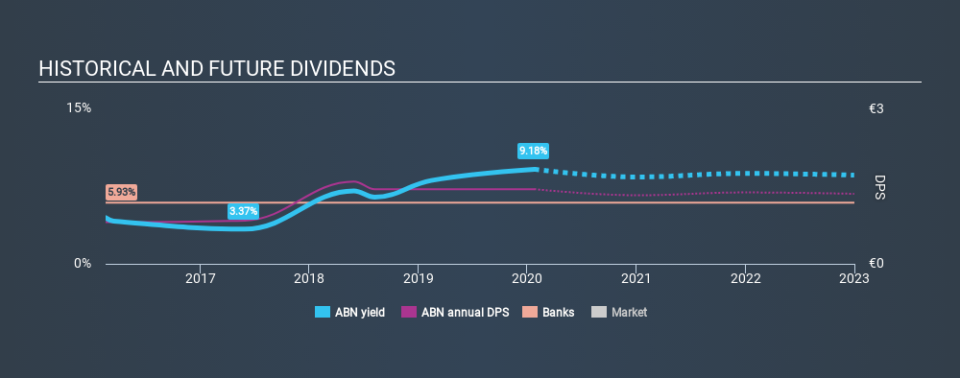Is ABN AMRO Bank N.V. (AMS:ABN) A Good Fit For Your Dividend Portfolio?

Is ABN AMRO Bank N.V. (AMS:ABN) a good dividend stock? How can we tell? Dividend paying companies with growing earnings can be highly rewarding in the long term. Yet sometimes, investors buy a popular dividend stock because of its yield, and then lose money if the company's dividend doesn't live up to expectations.
With a four-year payment history and a 9.2% yield, many investors probably find ABN AMRO Bank intriguing. It sure looks interesting on these metrics - but there's always more to the story . Some simple analysis can offer a lot of insights when buying a company for its dividend, and we'll go through this below.
Click the interactive chart for our full dividend analysis
Payout ratios
Companies (usually) pay dividends out of their earnings. If a company is paying more than it earns, the dividend might have to be cut. So we need to form a view on if a company's dividend is sustainable, relative to its net profit after tax. In the last year, ABN AMRO Bank paid out 68% of its profit as dividends. This is a healthy payout ratio, and while it does limit the amount of earnings that can be reinvested in the business, there is also some room to lift the payout ratio over time.
Remember, you can always get a snapshot of ABN AMRO Bank's latest financial position, by checking our visualisation of its financial health.
Dividend Volatility
One of the major risks of relying on dividend income, is the potential for a company to struggle financially and cut its dividend. Not only is your income cut, but the value of your investment declines as well - nasty. Looking at the data, we can see that ABN AMRO Bank has been paying a dividend for the past four years. It has only been paying dividends for a few short years, and the dividend has already been cut at least once. This is one income stream we're not ready to live on. During the past four-year period, the first annual payment was €0.81 in 2016, compared to €1.45 last year. This works out to be a compound annual growth rate (CAGR) of approximately 16% a year over that time. ABN AMRO Bank's dividend payments have fluctuated, so it hasn't grown 16% every year, but the CAGR is a useful rule of thumb for approximating the historical growth.
So, its dividends have grown at a rapid rate over this time, but payments have been cut in the past. The stock may still be worth considering as part of a diversified dividend portfolio.
Dividend Growth Potential
Given that the dividend has been cut in the past, we need to check if earnings are growing and if that might lead to stronger dividends in the future. Strong earnings per share (EPS) growth might encourage our interest in the company despite fluctuating dividends, which is why it's great to see ABN AMRO Bank has grown its earnings per share at 11% per annum over the past five years. Earnings per share have been growing rapidly, but given that it is paying out more than half of its earnings as dividends, we wonder how ABN AMRO Bank will keep funding its growth projects in the future.
Conclusion
Dividend investors should always want to know if a) a company's dividends are affordable, b) if there is a track record of consistent payments, and c) if the dividend is capable of growing. ABN AMRO Bank's payout ratio is within normal bounds. We were also glad to see it growing earnings, but it was concerning to see the dividend has been cut at least once in the past. In summary, we're unenthused by ABN AMRO Bank as a dividend stock. It's not that we think it is a bad company; it simply falls short of our criteria in some key areas.
Companies that are growing earnings tend to be the best dividend stocks over the long term. See what the 19 analysts we track are forecasting for ABN AMRO Bank for free with public analyst estimates for the company.
We have also put together a list of global stocks with a market capitalisation above $1bn and yielding more 3%.
If you spot an error that warrants correction, please contact the editor at editorial-team@simplywallst.com. This article by Simply Wall St is general in nature. It does not constitute a recommendation to buy or sell any stock, and does not take account of your objectives, or your financial situation. Simply Wall St has no position in the stocks mentioned.
We aim to bring you long-term focused research analysis driven by fundamental data. Note that our analysis may not factor in the latest price-sensitive company announcements or qualitative material. Thank you for reading.

 Yahoo Finance
Yahoo Finance 
